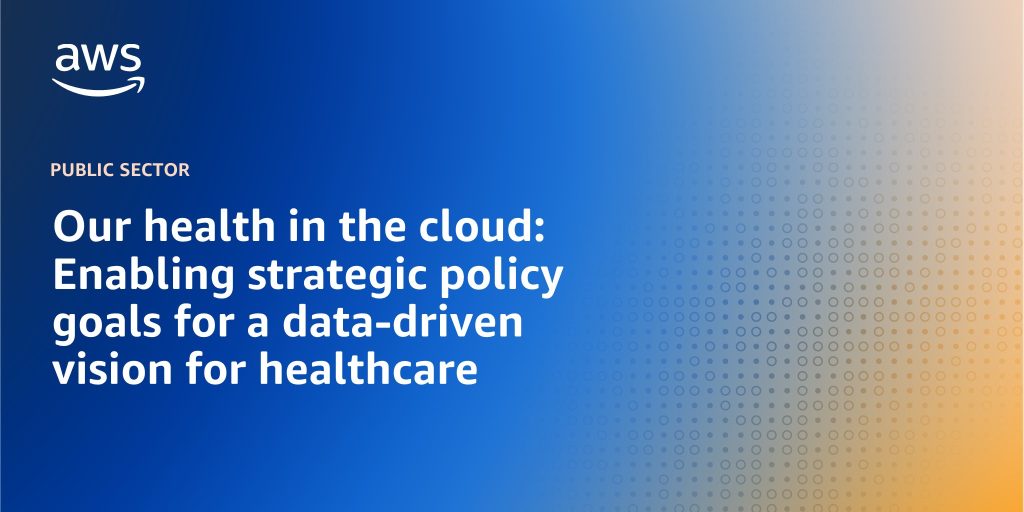AWS Public Sector Blog
Tag: patient data
Brain Data Science Platform increases EEG accessibility with open data and research enabled by AWS
About 4.5 million electroencephalogram (EEG) tests are performed in the US each year. That’s more than if every person in Oregon, Connecticut, or Iowa got an EEG. Because they provide insights into brain activity and not just structure, EEGs are one of the most common tests ordered by doctors to help make a diagnosis for people with brain problems. The Brain Data Science Platform (BDSP), hosted on Amazon Web Services (AWS), is increasing EEG accessibility through cooperative data sharing and research enabled by the cloud. Read this post to learn more.
Our health in the cloud: Enabling strategic policy goals for a data-driven vision for healthcare
The advent of cloud technology, coupled with advances in fields like epidemiology, genomics, and data analytics, has led to transformational change in how we use data in health. These developments enable a data-driven approach in individual care, public health, and health-related research.
Transforming radiology workflows with clinical decision support powered by AWS
The healthcare technology (HealthTech) startup contextflow uses AWS to power its clinical decision support system that can help radiologists diagnose patients faster and with more accuracy. The software can search, retrieve, and compare historical diagnostic data to help guide radiologists in writing reports. It is currently being utilized to analyze lung computed tomography (CT) scans for interstitial lung diseases (ILD), chronic obstructive pulmonary disease (COPD), and lung cancer screenings.
Solving medical mysteries in the AWS Cloud: Medical data-sharing innovation through the Undiagnosed Diseases Network
It takes a medical village to discover and diagnose rare diseases. The National Institutes of Health’s Undiagnosed Diseases Network (UDN) is made up of a coordinating center, 12 clinical sites, a model organism screening center, a metabolomics core, a sequencing core, and a biorepository. For many years prior to the UDN, the experts at these sites were limited by antiquated data-sharing procedures. The UDN leadership realized that if they wanted to scale up and serve as many patients as possible, they needed to transform how they process, store, and share medical data—which led the UDN to the AWS Cloud.
How to deploy HL7-based provider notifications on AWS Cloud
Electronic notifications of patient events are a vital mechanism for care providers to improve care coordination and promote appropriate follow-up care in a timely manner. This post shows how a combination of Amazon Web Services (AWS) technologies, like AWS Lambda, Amazon Comprehend Medical, and AWS Fargate, can effectively manage and deliver actionable data to help healthcare customers deliver electronic notifications in a secure and efficient way.
Wellforce announces migration of the health system’s digital healthcare ecosystem to AWS
By taking the lead in digital healthcare transformation, Wellforce is estimated to save as much as 20 percent annually (approximately $3 million USD) through the modernization of the healthcare IT ecosystem using the cloud. This innovative approach serves as one of the first examples that healthcare systems across the nation, and world, can replicate.
NYU Langone Center increases MRI accessibility through cooperative data sharing and research
About 40 million MRI scans are performed in the United States every year. MRIs are a valuable part of diagnostic plans, but as they exist today, they may not always be a part of a patient’s care plan. A research team at the New York University (NYU) Langone Center set out to make MRIs more accessible for more patients by using artificial intelligence (AI), machine learning (ML), and the power of cooperative open data sharing.
How AWS and blockchain make it possible to meet the challenges of interoperability in healthcare
Health information is generally disorganized, unstructured, and stored in various formats, making it impractical to trace patient history and promote the exchange of information on a national scale with other health professionals. A solution to this issue is the creation of a unique patient registry, which can be defined as a repository of retrospective, current, and prospective information of the patient in digital format. The main objective of this registry is to promote integrated, continuous, efficient, quality health care. In addition, the registry needs to be accessible and available to different health institutions. When building these registries, it’s necessary to use standards to define not only how the information is structured, but also how it can be retrieved and shared among the different HIS in a safe, scalable, cost-efficient way. This can be done using blockchain.







